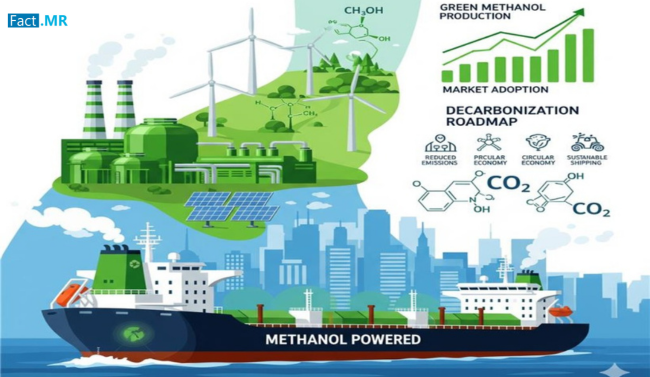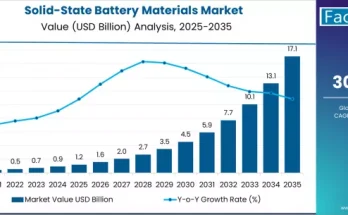The green methanol market is undergoing transformative changes. The green methanol industry is projected to expand substantially from USD 1,121 million in 2025 to USD 6,769 million by 2035, growing at a compound annual growth rate (CAGR) of 19.7%. This rapid growth reflects a convergence of regulatory pressure, decarbonization efforts, and technological advancements across industries.
Drivers of Growth Across Feedstocks
Green methanol production is based on a variety of feedstocks, and each pathway is evolving differently. Biomass remains the dominant feedstock in emerging economies, particularly in regions where agricultural or forestry waste is abundant. As of 2025, biomass-based green methanol accounts for the majority share of production worldwide. Alongside biomass, renewable hydrogen combined with captured CO₂—often referred to as e-methanol—is gaining prominence, especially in regions with strict carbon regulations. Large-scale projects in Europe are spearheading the growth of e-methanol, supported by renewable energy capacity and carbon capture infrastructure. Hybrid feedstock models are also emerging, blending biomass, captured CO₂, or waste streams to provide flexibility and cost efficiency. Such models are proving attractive in regions where diverse feedstock availability and modular systems help manage supply chain risks.
Expanding Applications of Green Methanol
The applications of green methanol are broad, but some are expected to grow faster than others. Maritime fuel is currently the most significant driver of demand, and is projected to dominate global consumption through the forecast period. With the shipping sector under immense pressure to decarbonize, green methanol offers a viable solution as both an immediate and long-term fuel alternative.
Beyond shipping, chemical intermediates remain a crucial segment, with methanol used extensively in large-scale industrial chemistry, formaldehyde, and methanol-to-olefins processes. Power generation and grid balancing is another promising use, particularly in regions with high renewable energy penetration, where methanol can serve as a backup or peaking fuel. Transportation fuels beyond marine, such as heavy trucking and road transport blending, are expected to grow steadily as engine technologies adapt. Heating and cooking fuel applications, while smaller in scale, are likely to see gradual adoption in regions where cleaner household energy sources are a policy priority.
End-Use Industry Trends
Demand for green methanol is being driven by a diverse set of end-use industries. The shipping and marine logistics sector is currently the leading consumer, owing to global regulations targeting emissions reductions and the push for low-carbon bunkering solutions. Chemicals and petrochemicals follow closely, with industries under increasing pressure to decarbonize their operations and reduce the carbon intensity of feedstocks. Utilities and power providers are also adopting green methanol as part of their efforts to stabilize renewable-heavy grids.
The transportation industry more broadly is beginning to incorporate methanol-compatible engines, and industrial processing sectors such as steel, cement, and fertilizers are exploring methanol as a cleaner alternative to fossil-based fuels or as a sustainable feedstock. These industries represent some of the hardest sectors to decarbonize, making green methanol a particularly attractive option.
Regional Market Landscape
Green methanol adoption varies significantly across regions. North America is benefiting from strong policy support and large industrial infrastructure, with several projects combining renewable hydrogen production, carbon capture, and methanol synthesis. Latin America is exploring its biomass resources and renewable energy potential, positioning itself as a future low-cost producer and exporter.
Western Europe is at the forefront of adoption, with countries such as Germany, Denmark, and the Netherlands investing heavily in marine fuel corridors, electrolyzers, and e-methanol projects. Eastern Europe is less mature but expected to follow suit as regulations and infrastructure develop. In East Asia, China is playing a dominant role by integrating green methanol into hybrid coal and carbon capture pathways, while Japan and South Korea are also exploring its use in transport and power.
South Asia and the Pacific are focusing on biomass-based methanol production, with India in particular investing in domestic gasification projects. The Middle East and Africa have significant potential, both as feedstock providers and as exporters, though financing and infrastructure remain hurdles.
Competitive Landscape and Recent Developments
The competitive dynamics of the green methanol market are evolving quickly. Key players include companies specializing in methanol production, renewable energy, carbon capture, and shipping. Firms such as Methanex, Proman, BioMCN, Hy2gen, and Carbon Recycling International are investing in scaling up production and developing new technologies. Shipping giant Maersk is among the most visible adopters, ordering methanol-ready vessels and partnering with producers to secure long-term fuel supply.
Technology providers like Siemens Energy and Haldor Topsoe are advancing electrolyzer systems and methanol synthesis processes that make e-methanol more cost-competitive. New entrants such as Liquid Wind and Twelve are working on smaller, modular plants designed for decentralized production, catering to regional and niche needs.
Recent market developments highlight the rapid pace of change. For example, new dual-fuel vessels are being delivered to global shipping fleets, marking a large-scale shift toward green fuels. Significant funding for green industrialization has also been secured in regions like Africa, underscoring the global interest in scaling up production capacity.
Market Challenges and Restraints
Despite its strong growth trajectory, the green methanol market faces significant challenges. One of the biggest hurdles remains cost. Green methanol is considerably more expensive than conventional fossil-based methanol, largely due to the high costs of electrolyzers, renewable hydrogen, and carbon capture technologies. Feedstock sustainability is another concern, particularly with biomass, where issues such as deforestation, biodiversity, and land-use change need to be addressed.
Regulatory uncertainty also creates risks. Standards for what qualifies as “green” methanol are still evolving across different regions, and certification schemes vary widely. This lack of harmonization complicates cross-border trade and makes it harder for investors to commit to long-term projects.
Conclusion
The green methanol market is transitioning from pilot projects to large-scale deployment, driven by a combination of regulatory mandates, technological innovation, and rising demand from industries such as shipping, chemicals, and power generation. With its projected CAGR of 19.7% and strong momentum across regions, green methanol is set to become one of the most important fuels in the global transition to a low-carbon economy.



